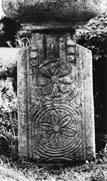Select a site alphabetically from the choices shown in the box below. Alternatively, browse sculptural examples using the Forward/Back buttons.
Chapters for this volume, along with copies of original in-text images, are available here.
Object type: Part of cross-shaft
Measurements: H. 62 cm (24.4 in); W. 37 > 34 cm (14.6 > 13.4 in); D. 24 > 22 cm (9.4 > 8.7 in)
Stone type: [Ancaster Freestone, Upper Lincolnshire Limestone, Inferior Oolite Group]
Plate numbers in printed volume: 434–7
Corpus volume reference: Vol 5 p. Vol 5 pp. 319–20
(There may be more views or larger images available for this item. Click on the thumbnail image to view.)
In the back garden of Cherry Tree Farm, Aunsby. The property of Mrs Fairchild.
Found in delivery of building rubble to farm. Came from churchyard nearby' (Lincoln City and County Museum record card). The late Mr Fairchild recalled that this was about 1970 (pers. comm.). It may have been reused in later medieval building work at St Thomas's church and discovered during modern restorations. There was an extensive restoration in 1861 (Cox 1924, 49).
Good. The carved surfaces are slightly weathered.
The upper part of a tapered standing shaft decorated in low relief on its two broad faces. All four angles of the shaft are delineated by a pronounced roll moulding. The shaft has been recut at the head end where two downward-sloping rebates have been cut into faces B and D and the original surfaces of A and C have been cut smooth. The present base is formed by a secondary surface, cut subsequent to the stone's primary use.
A (broad): The decoration of the central and lower parts of the shaft consists of a series of circular motifs placed one over the other. Each circle is defined by a series of concentric mouldings with small triangular panels decorated with circular bosses at their intersections. The lowest circle is only represented by the border moulding but the remaining two are filled with stylised flower-like patterns, the lower with six pointed petals with bosses between each pair, the upper without the intervening bosses but having eight petals with blunt ends. Above the uppermost circle the mouldings forming the circular borders extend upwards towards the top of the shaft in straight lines and are flanked by rows of circular bosses.
B and D (narrow): Undecorated, except for the angle mouldings.
C (broad): This face is laid out in a similar fashion to A, with three circular motifs formed by raised mouldings placed one above the other. The interstices are occupied by similar panels. The decoration within the circular motifs is also similar except that the octofoil figure with blunt petals sits below the sexfoil. The third figure is more complete on this face; enough of the central part of the circular panel is preserved to suggest a four-lobed 'flower' with pointed petals.
Appendix G item (the continuing tradition).
This is clearly a section from a minor standing cross, perhaps originally a grave-marker. There can be no mistaking the date of the motifs with which the shaft is decorated. They belong to the mainstream of Romanesque decoration occurring in the first half of the twelfth century. The national tradition of similar circular motifs is well represented in Lincolnshire, for example on the tympana at Bishop Norton (Binnall 1961) and South Ferriby (Keyser 1883) and in the chancel arch jambs at Middle Rasen and capitals at Bassingthorpe. The only securely dated examples are the small paterae which decorate the jambs and hood-mouldings of the central door of the Cathedral west front, which are probably from the later 1140s or 1150s (Zarnecki 1988; Stocker 1991, 33–7). Although these paterae have only a passing resemblance to those decorating the Aunsby shaft, they do illustrate the use of such motifs in the county in the central part of the twelfth century.
Similar motifs are used at the same period to decorate funerary monuments. Tiers of circular motifs are employed on the coffin lid no. II/24 from St Mark's, Lincoln (Stocker 1986a, fig. 55; id. 1988, fig. 7) for which a mid twelfth-century date has also been suggested, and very similar motifs are found decorating the cross-head on the grave-cover fragment which is now loose in Canwick churchyard. The cross-head type at Canwick is allocated to the late twelfth century by Butler (1964, 127–31). The late cross-shaft at Castle Bytham (no. 2) is decorated with two circular motifs of very much the same type (Ills. 450, 452), though these motifs are not bound together in a single design as they are at Aunsby. The unusual monument at Barrowby (no. 2) has a very similar sexfoiled motif to Aunsby (Ills. 433, 438), whilst the cross-head at Londonthorpe (no. 1) also comes from a shaft of similar size to the Aunsby example and has one face (A) decorated with a very similar sexfoiled flower (Ill. 466). Aunsby, Londonthorpe and Barrowby are within ten miles of each other and all are within easy reach of the Ancaster quarries, which, petrologically, appears to be a likely source for their stone.
Unpublished



